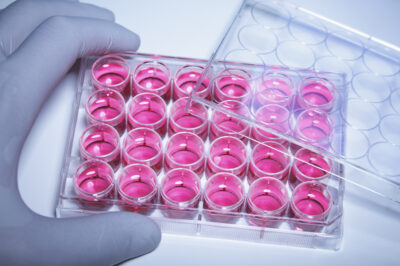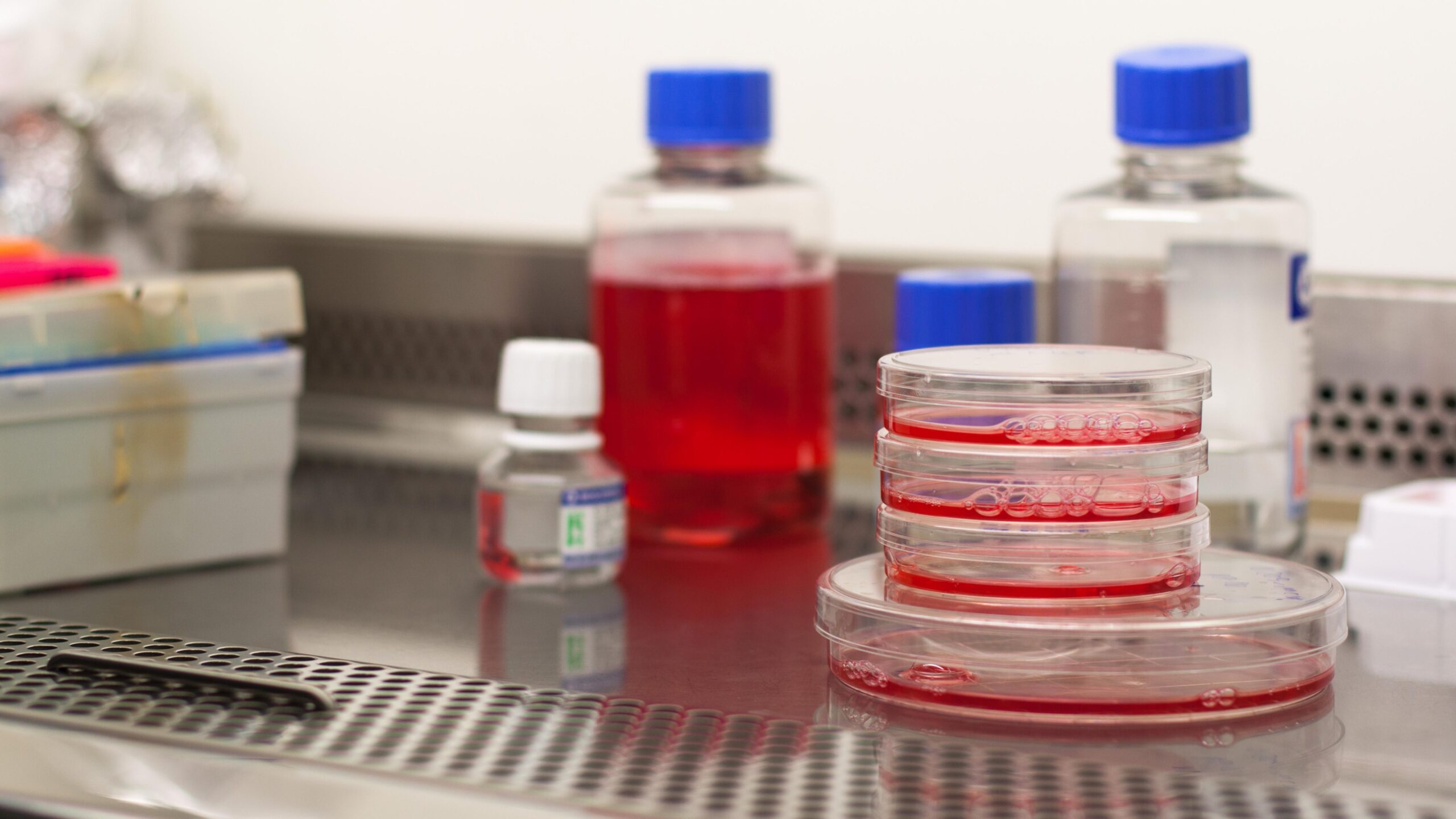Cell culture is a fundamental technique used in biological and biomedical research, allowing scientists to study cells in a controlled environment. However, despite the best efforts to maintain sterility, contamination remains a major challenge in cell culture labs. Contaminants can negatively impact experimental outcomes, waste valuable resources, and cause irreparable damage to research integrity. Understanding the common sources of contamination and how to prevent them is crucial for successful cell culture work.

Multi-well dish containing cell culture medium
1. Bacterial Contamination
Sources: Bacteria are one of the most common and easily introduced contaminants in cell culture. They can originate from a variety of sources, including improperly sterilized equipment, contaminated reagents, or poor aseptic techniques during culture handling.
Common Types:
Gram-positive bacteria: These include Staphylococcus and Bacillus species, which can cause rapid culture degradation.
Gram-negative bacteria: These often include Pseudomonas or Escherichia coli, which can proliferate quickly and produce harmful endotoxins.
Effects on Cultures:
Bacteria can overgrow and outcompete the cultured cells for nutrients, leading to cell death or altered cell growth patterns.
They can alter the pH of the medium, often making it more acidic, which can further harm cell cultures.
The presence of bacteria may also release toxins that can interfere with experimental results, especially in drug testing or protein studies.
Prevention:
Practice stringent aseptic techniques, such as wearing gloves, disinfecting surfaces, and working under a laminar flow hood.
Regularly sterilize all equipment and consumables.
Use antibiotics in culture media as a precautionary measure, although it’s better to identify and eliminate the source of contamination.
2. Fungal Contamination
Sources: Fungal contamination typically comes from mold spores present in the air or on improperly cleaned surfaces. Fungal contaminants can also be introduced through contaminated reagents, particularly media, or from personnel working in unclean lab environments.
Common Types:
Aspergillus and Candida species are among the most frequently encountered fungal contaminants in cell culture.
Effects on Cultures:
Fungi can grow rapidly, often forming visible colonies that can easily overtake cell cultures.
Fungal growth can cause physical changes in the appearance of the culture, such as the development of clumps or fuzzy growth on the surface.
Fungal contamination can introduce mycotoxins, which can be toxic to cells and affect the reliability of experimental outcomes.
Prevention:
Ensure that the lab environment is kept clean and that all equipment and materials are properly sterilized before use.
Use air filtration systems or laminar flow hoods when handling cultures.
Avoid working with cultures in open-air environments and always disinfect surfaces before use.
3. Mycoplasma Contamination
Sources: Mycoplasmas are tiny, bacteria-like organisms that lack a cell wall, making them resistant to many antibiotics. They can be introduced into cell cultures through contaminated culture media, reagents, or cross-contamination from other cell cultures or laboratory personnel.
Effects on Cultures:
Mycoplasma can cause subtle alterations in cell growth and metabolism, which may go unnoticed unless specifically tested for.
They can alter cellular morphology, reduce cell proliferation, and interfere with protein synthesis, thus affecting experimental data.
Mycoplasma contamination is often asymptomatic, so cultures can appear healthy but still produce unreliable or inconsistent results.
Prevention:
Regular screening for mycoplasma contamination using PCR-based methods or commercial mycoplasma detection kits.
Maintain strict protocols for handling cultures to prevent cross-contamination.
Use of certified, mycoplasma-free reagents and media whenever possible.
4. Viral Contamination
Sources: Viral contaminants can be introduced through infected cell lines, contaminated biological reagents, or even through airborne particles. Viruses can be particularly dangerous because they can remain latent in cultures and affect cell behavior without being immediately detected.
Common Types:
Retroviruses, adenoviruses, and other animal viruses are commonly found as contaminants in cell cultures, especially in facilities working with mammalian cells.
Effects on Cultures:
Viruses can alter the genetic makeup of cultured cells, making them unsuitable for experiments requiring consistency in genetic expression.
Viral infections can cause cells to undergo unwanted transformations, such as oncogenesis (cancer formation), which can affect research accuracy.
They can also damage the integrity of the cell culture environment, leading to cell death or loss of function.
Prevention:
Use virus-free cell lines that are well-characterized and screened for contaminants.
Implement strict quarantine procedures for new cell lines and reagents before introducing them into the culture room.
Work in virus-free environments and regularly disinfect surfaces and equipment.
5. Cross-Contamination of Cell Lines
Sources: Cross-contamination occurs when one cell line contaminates another, typically when cultures are handled in proximity without proper precautions. This can also occur if there’s a mix-up in cell lines during culture propagation.
Effects on Cultures:
Cross-contamination can lead to misidentification of cell lines, which can significantly compromise experimental results.
It may lead to the proliferation of unwanted cell types, making it difficult to isolate and study specific cellular behavior or responses.
Prevention:
Properly label all cell culture containers and maintain good record-keeping to avoid confusion between cultures.
Use dedicated equipment and materials for each cell line to prevent accidental cross-contamination.
Perform regular cell line authentication using STR (short tandem repeat) profiling to verify the identity of the cultures.
6. Contaminated Culture Reagents and Media
Sources: Culture media, serum, and reagents can be a source of contamination if not properly sterilized or handled. Commercially available reagents should be sourced from reputable suppliers and checked for contamination.
Effects on Cultures:
Contaminated reagents can introduce bacteria, fungi, or viruses into cultures, leading to unpredictable results.
Reagents can also introduce unwanted chemicals or contaminants that affect cell health and behavior.
Prevention:
Purchase reagents and media from trusted, certified vendors who follow good manufacturing practices (GMP).
Sterilize all homemade media and reagents before use, and regularly check expiration dates. Always store reagents at the correct temperature and in a clean environment.
Conclusion
Contamination is an ever-present risk in cell culture, but by understanding its common sources and implementing strict aseptic techniques, scientists can minimize the chances of contamination and maintain the integrity of their experiments. By staying vigilant and regularly monitoring cultures for signs of contamination, you can ensure that your research produces accurate, reproducible results. Whether it’s bacteria, fungi, mycoplasma, viruses, or cross-contamination, prevention and early detection are the keys to successful cell culture work.





